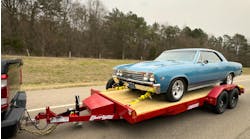This month, assuming no big surprises, the post-Great Recession economic expansion will set a record as it moves into its tenth year—and trailer manufacturers have benefited throughout. But ACT Research Economist Jim Meil sees some “yellow signals” in the economic data to be aware of, even as he projects another record year for trailer production in 2019, and a pretty good 2020.
Meil rolled out his crystal ball during the Thursday general session at the TTMA convention.
“So we have some happy news and some not-so-happy news,” Meil said, and among his “happy” bullets points are positive indicators for business/consumer confidence; a strong job market; growth in corporate profits; the stock market; and credit standards and loan availability.
But while the economic news from Main Street is good, many of the anxieties stem from events in Washington and business conditions in the rest of the world: trade negotiation risk; Federal Reserve rate increases; a flat yield curve; slower growth in manufacturing, along with a decline in housing; the 2020 election cycle, which is already under way; and a weaker global economy and global troubles.
The converging yield curve (the spread between long-term and short-term yield rates) is one of Meil’s favorite leading indicators, and it’s currently “flashing yellow.”
“The story is that we think we’re walking on thinner ice,” he said. “So if you’re going to take away anything from this presentation, keep in mind the fact that this is something to watch out for.”
In other indicators, he noted that the ISM Purchasing Managers’ Index for manufacturing, while still positive, has begun to decline. The NFIB Small Business Optimism Index, which soared after the 2016 election, also has recently fallen after two years of sustained highs.
“Many of your customers are, relatively speaking, not Fortune 500 companies; they’re small businesses. And are small businesses confident right now? The story is, by and large, yes,” Meil said, and that’s largely the result of the change in administrations—and the federal policy differences between having a regulation-inclined Democrat versus a pro-business Republican in the White House. But a new election season, and the associated uncertainty, is underway. “In the last few months, since October of last year, we’ve seen a little bit of erosion [in the optimism index]. You be the judge.”
Similarly, the stock market has trended upward for much of the past two years.
“So the picture of the economy, when you net all of these results, is that we’re in pretty good shape,” Meil said. “The one indicator with a proven track record there we’re a little bit worried about is the yield curve. And the one wonderful thing about the yield curve is there is about a four- to six-quarter advance warning of the coming recession.”
Equipment outlook
The prolonged economic recovery has meant plenty of freight moves—and that’s been good for truckers.
“Your customers had a hellaciously good 2017 and 2018,” Meil said. “And that was compounded by the capacity shortage in late 2017. Too much freight and too little capacity—so basically, the bottom-line story is two terrific years for those who were in position to provide capital equipment to the transportation business.
“The fundamental thing that we’ve got right now is the industry tends to be a very volatile industry. It’s either Fat City, or Death Valley. And we think the second half of 2019 could represent this transition, where the market goes from shortage to equilibrium then capacity equipment excess.”
Illustrating his point with truck tonnage and pricing data, Meil pointed to the beginnings of a downturn—even as business is still “prosperous.”
So what does this mean for trailer demand? ACT’s tracking shows trailer orders to be in a “holding pattern.”
“The good news is the backlog is so extensive that it’s providing a considerable cushion in the industry,” Meil said. “That’s one of the reasons that we think 2019 is going to see record industry volumes … but the evidence points to the fact that we’re topping out right now.
“So celebrate the fact that we’re going to see trailer production, in essence, over the course of this year will slightly exceed the 2018 peak and mark a terrific decade for the business. Be aware that we’re going to see a powerful 2020, but it will probably be a step down from the territory we’re at right now.”
Looking at data going back to 2009, he called the recent decade “remarkable” not only for the rise in volume but also for the “stability” in the market.
So while ACT forecasts a 17% slip in trailer production for 2020, in essence the market grade is going from an A+ to an A- or B+.
“And we’re far away from hopping on academic probation, the way we were back in the last recession,” Meil added.
But he noted that there is another downside to the decade of prosperity, namely that the fleet has been “refreshed,” with the trailer population surging from 2.8 million to 3.2 million, and the average age has fallen from 8.2 years to 6.8 years, according to ACT data.
“And, in many senses, what that means is that in order to continue the kind of volumes we’ve seen, we need for the economy to at least sustain pretty good performance the way it has over the course of these last 10 years,” he said. “The other indication is that if we had a recession it will be pretty tough, because the equipment out there is by and large fresh equipment.”
Meil’s summary of the presentation was to the point: “Go out, sell the heck out of new equipment in 2019, have a party—and know that 2020 is probably going to be pretty good,” he said. “But keep an eye on those yellow lights.”









